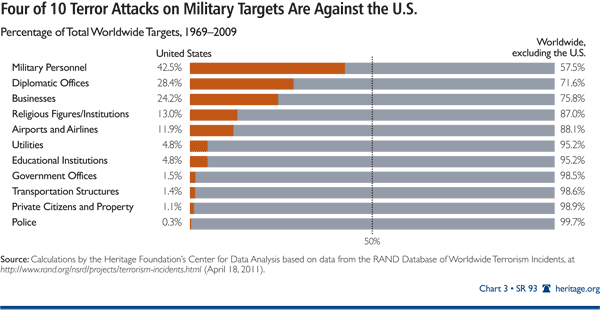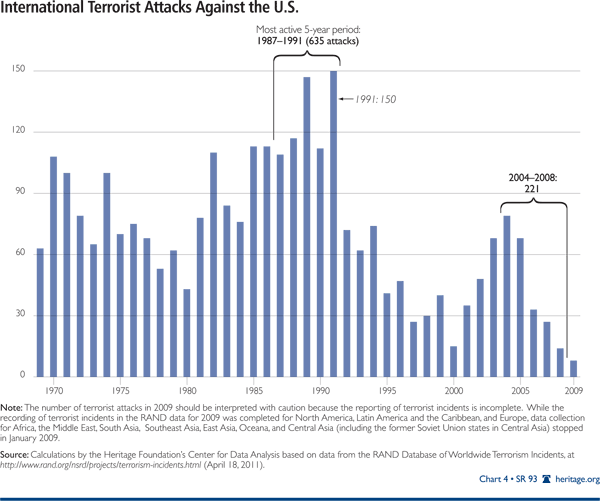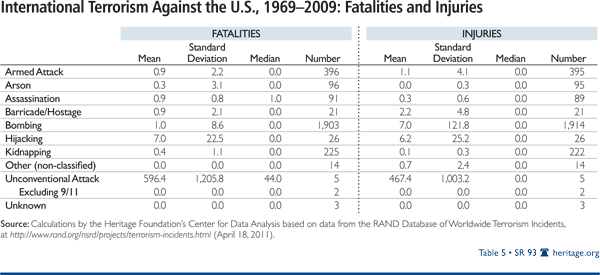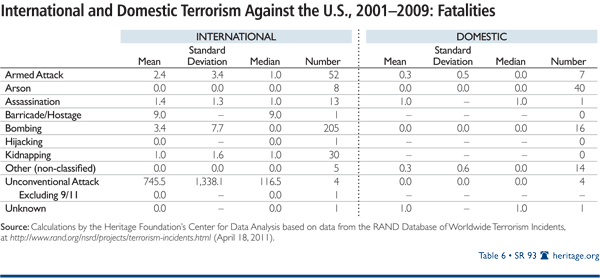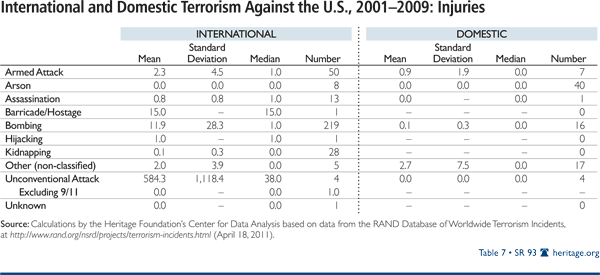On September 10, 2001, Osama bin Laden’s name was well known to the U.S. intelligence community. By that point, bin Laden had directed various attacks against the U.S. through the al-Qaeda terror network, including the 1993 World Trade Center bombing and the 1998 U.S. embassy bombings in Africa. Yet, despite the fact that “the threat of transnational terrorism was widely recognized by the IC [intelligence community] and policymakers, virtually no initiatives were taken to address the deep-seated limitations of U.S. strategic intelligence that made it an inadequate instrument for meeting its threat.”[1]
The 9/11 attacks, and the subsequent publication of The 9/11 Commission Report served as a tremendous catalyst for a much-needed and robust debate over the nature of the threat facing the United States. The report also drew significant attention to the nation’s intelligence failures and lack of a framework for preventing, preparing for, and responding to acts of terrorism.
The national conversation that followed, specifically about the lessons learned from 9/11, continues to play a significant role in discussions related to the very definition of terrorism, the extent and severity of the threat, and the best methods for stopping future attacks. In many ways, the U.S. has taken this information and acted on it—drastically reforming the federal effort on homeland security, breaking down communication walls between law enforcement and intelligence, providing law enforcement with better intelligence-gathering tools, and forging a national homeland security enterprise composed of federal, state, and local assets, as well as private citizens.
As a result, law enforcement has foiled at least 39 terror plots since 9/11.[2] Simply put, the intelligence and law enforcement communities are better able to track down leads in local communities than they were on September 10, 2001.
A decade later and shortly after the demise of Osama bin Laden, it is as important to look backward as it is to look forward in order to keep learning from the past and to examine the threats now facing the U.S. The survey presented in this paper aggregates international data on terrorism around the world from the past 40 years. Combined with new intelligence, such data can better inform counterterrorism decisions and continue the process of delineating enhanced homeland security policies for the future. The onus is now on the President and Congress to continue to hone and sharpen U.S. counterterrorism capabilities and adapt them to evolving 21st-century threats.
Summary of Research
Between 1969 and 2009, there were 38,345 terrorist incidents around the world. Of these attacks, 7.8 percent (2,981) were directed against the United States, while 92.2 percent (35,364) were directed at other nations of the world:
- Nearly 5,600 people lost their lives and more than 16,300 people suffered injuries due to international terrorism directed at the United States;
- While terrorist attacks against the U.S. tend to be slightly deadlier (2.01 fatalities per incident) than attacks against other nations (1.74 fatalities per incident), the higher number of average fatalities for the United States is a consequence of 9/11;
- Terrorism directed at the United States accounts for only 7.8 percent of all terrorism worldwide, but almost 43 percent of all attacks against military institutions are leveled against U.S. institutions; and
- Furthermore, 28.4 percent and 24.2 percent of all worldwide terrorist attacks against diplomatic offices and businesses, respectively, are aimed at U.S. institutions.
Between 2001 and 2009:
- There were 91 homegrown terrorist attacks of all kinds against the United States, while there were 380 international terrorist attacks against the United States;
- The two most prevalent U.S. targets of international terrorism were businesses (26.6 percent) and diplomatic offices (16.6 percent);
- The two most prevalent U.S. targets of domestic terrorism were businesses (42.9 percent) and private citizens and property (24.2 percent); and
- The preferred method of attack against the United States for international terrorists was bombings (68.3 percent), while the preferred method for domestic terrorists was arson (46.2 percent).
The Data
The data used in this descriptive analysis by The Heritage Foundation stem from the RAND Database of Worldwide Terrorism Incidents (RDWTI).[3] The version of the RDWTI used in this analysis contains information on nearly 38,700 terrorist incidents from across the globe between February 1968 and January 2010. For this analysis, terrorist incidents were counted only if the recorded incidents were officially confirmed as a terrorist incident by RAND in the database. In addition, state-sponsored terrorist attacks are excluded from the analysis. The data are limited to incidents that occurred during a 40-year time span from 1969 to 2009. However, this figure underestimates the number of terrorist incidents because the last entries are not complete for all countries.[4]
To keep the RDWTI up-to-date, RAND staff with regional and language expertise review incidents around the world that can be potentially defined as terrorism.[5] In addition, terrorist incidents must be confirmed as such through press reports before they can be officially counted. While the version of RDWTI used by The Heritage Foundation covers terrorist incidents through January 2010, not all cases of recent terrorism are included in this analysis (such as the November 2009 massacre at Fort Hood perpetrated by U.S. Army Major Nidal Malik Hasan). As with any database that tries to contain the most current information, there are necessary delays in confirming cases of terrorism to ensure the incidents are correctly recorded.
An important attribute of the RDWTI is the consistent application of its definition of terrorism, as described by Professor Bruce Hoffman of Georgetown University:
[T]he deliberate creation and exploitation of fear through violence or the threat of violence in the pursuit of political change. All terrorist acts involve violence or the threat of violence. Terrorism is specifically designed to have far-reaching psychological effects beyond the immediate victim(s) or object of the terrorist attack. It is meant to instill fear within, and thereby intimidate, a wider “target audience” that might include a rival ethnic or religious group, an entire country, a national government or political party, or public opinion in general. Terrorism is designed to create power where there is none or to consolidate power where there is little. Through the publicity generated by their violence, terrorists seek to obtain the leverage, influence and power they otherwise lack to effect political change on either local or international scale.[6]
According to this definition, terrorism is defined by the nature of the incident, not by the identity of the perpetrators.[7] The fundamentals of terrorism include:
- “Violence or the threat of violence;
- “Calculated to create fear and alarm;
- “Intended to coerce certain actions;
- “Motive must include a political objective;
- “Generally directed against civilian targets; and
- “It can be [carried out by] a group or an individual.”[8]
Essentially, terrorism can be summarized as violent acts that are “calculated to create an atmosphere of fear and alarm to coerce others into actions they would not otherwise undertake, or refrain from actions they desired to take.”[9] Further, regular criminal acts are not counted as terrorism. So, while drug-trafficking conducted by the Revolutionary Armed Forces of Columbia (FARC) is not counted as terrorism,[10] FARC’s attacks against Colombian citizens are.[11]
A Descriptive Analysis of Worldwide Terrorism
Between 1969 and 2009, there were 38,345 terrorist incidents around the world. Of these attacks 7.8 percent (2,981) were against the United States, while 92.2 percent (35,364) were against the rest of the world. (See Chart 1.)
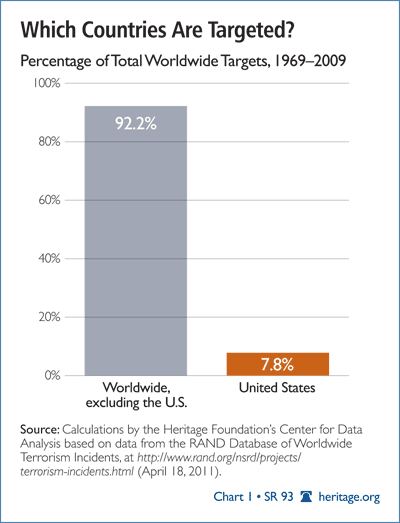
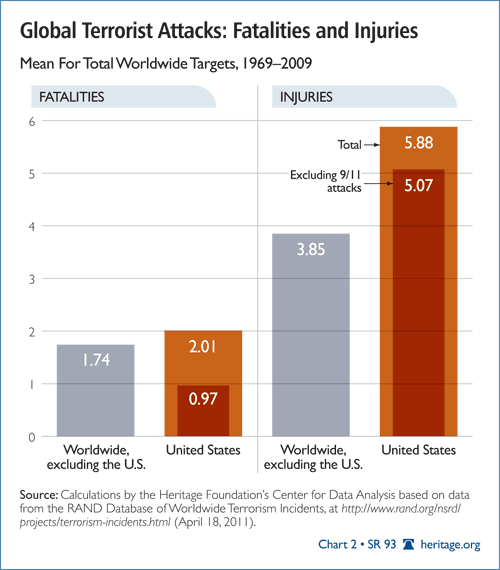
From 1969 to 2009, the average number of fatalities per terrorist attack against a nation other than the United States yielded 1.74 fatalities. (See Chart 2.) When the data are limited to incidents against the United States, the average terrorist attack yielded 2.01 fatalities per incident. These fatalities represent all individuals killed, not only Americans. Without 9/11, the average falls to 0.97 fatalities per attack.
Chart 2 also includes the mean for the number of injuries per terrorist incident. On average, terrorist attacks against nations other than the United States yielded 3.85 injuries. Attacks against the United States averaged 5.88 injuries. As with fatalities, the mean for injuries resulting from attacks against the United States is tied closely to 9/11. Without 9/11, the mean drops to 5.07 injuries per incident.
Chart 3 breaks down terrorism by type of institution targeted. The United States comprises a large share. Almost 43 percent of terrorist attacks against military institutions are against the U.S. Armed Forces. The United States also accounted for 28.4 percent and 24.2 percent of all terrorist attacks against diplomatic and business institutions, respectively. Alternately, the United States accounted for only a small percentage of attacks against police (0.3 percent), private citizens and property (1.1 percent), transportation systems (1.4 percent), and government institutions (1.5 percent).
Terror Against the U.S.
International terrorist attacks against the United States have fluctuated. (See Chart 4.) From 1969 to 1991, despite a few down flows, international terrorism against the U.S. was on the rise. In 1991, the trend peaked at 150 terror acts committed against U.S. interests. After 1991, international terror declined sharply until reaching its lowest low point of 14 incidents in 2000. In 2001, the trend reversed and rapidly increased until peaking in 2005 with 87 incidents. The number of attacks decreased until reaching the lowest point in 40 years in 2009 with five recorded international terrorist attacks against the United States. This number, however, needs to be interpreted with caution. While the record of terrorist incidents in the RDWTI for 2009 was completed for North America, Latin America, the Caribbean, and Europe, data collection for Africa, the Middle East, and Asia stopped in January 2009. Afghanistan incidents for 2009 were recorded through August. In addition, the attempted bombing of Northwest Flight 253 from Amsterdam to Detroit on December 25, 2009, by Umar Farouk Abdulmutallab, known as the “Underwear Bomber,” was not yet confirmed as a terrorist incident in the RDWTI.
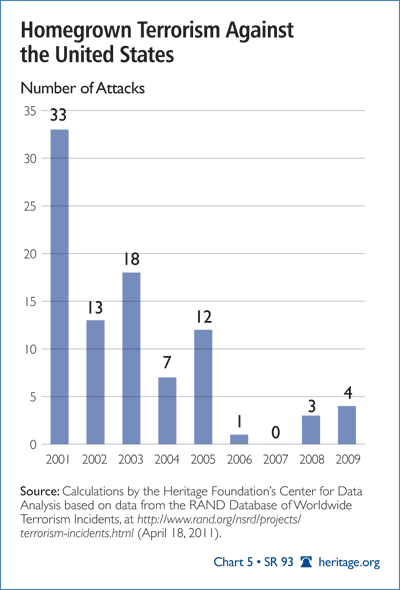
Since the RDWTI began to consistently collect information on incidents of homegrown domestic terrorism in the United States in only 2001, Chart 5 presents the trend from 2001 to 2009.[12] During this short time span, there were 91 homegrown domestic terrorist incidents. The peak year was 2001 with 33 domestic terrorist attacks against the United States. The number of domestic incidents then steadily decreased to zero recorded incidents in 2007. In 2008 and 2009, there were three and four recorded incidents, respectively.
Most acts of terrorism against the United States occur outside the nation’s borders. Since 1970, more than half of all international terrorist acts targeting the United States occurred in either Latin America and the Caribbean (36 percent) or Europe (23 percent). (See Chart 6.) The Middle East and Persian Gulf account for 20 percent. Anti-U.S. terrorist attacks were least likely to occur in Africa.
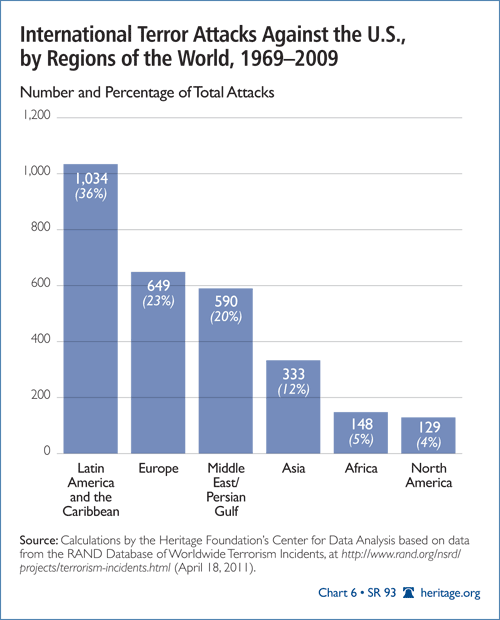
Terror Targets. Table 1 shows the frequency of international terrorist attacks against specific United States targets from 1969 to 2009. The top three targets were businesses (31.5 percent), diplomatic offices (26.7 percent), and military institutions (12.8 percent). The least prevalent targets of international terrorist attacks were abortion-related facilities (zero), food and water supply (0.03 percent), telecommunications (0.14 percent), and other terrorists or former terrorists (0.07 percent).[13]
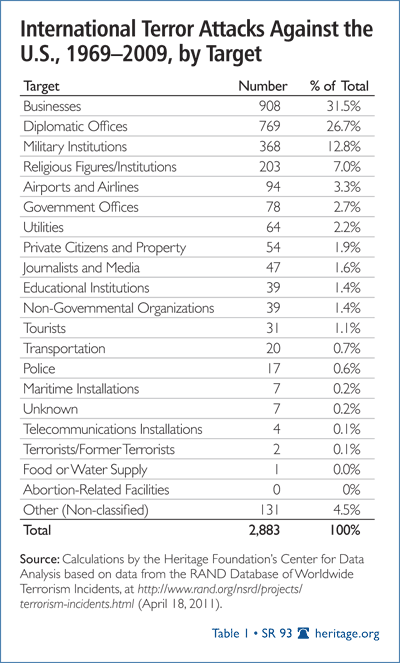
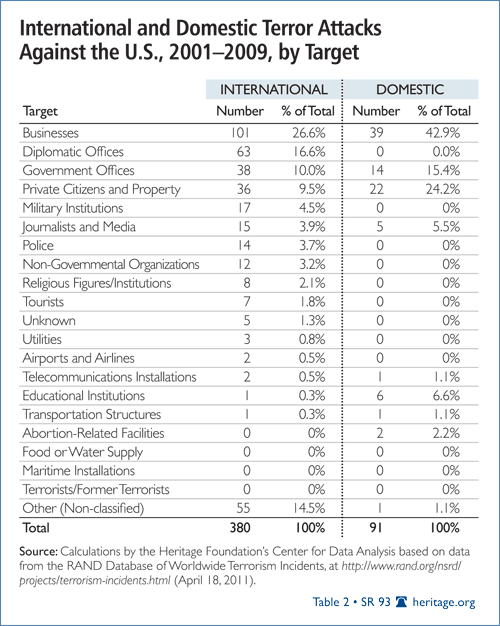
How similar are the patterns of domestic and international terrorism directed at the United States? Table 2 attempts to answer this question. For the 91 domestic terrorist incidents between 2001 and 2009, the most prevalent targets were businesses (42.9 percent), private citizens and property (24.2 percent), and government institutions (15.4 percent). The top three targets of international terrorism from 2001 to 2009 were businesses (26.6 percent), diplomatic institutions (16.6 percent), and other (non-classified) categories (14.5 percent).
While the RAND analysis finds no incidents of domestic terrorism targeting the U.S. Armed Forces, the version of RDWTI obtained by The Heritage Foundation, as mentioned, does not count the November 2009 Fort Hood massacre as a confirmed terrorist incident. Subsequent editions of the RDWTI will surely count the Fort Hood shooting as domestic terrorism targeting military institutions.
Terror Tactics. Table 3 presents the types of international terrorist tactics used in attacks against the United States from 1969 to 2009. Of the 2,883 international terrorist attacks against the United States, bombings accounted for 68.3 percent of all incidents. The second and third most prevalent tactics were armed attacks (14.0 percent) and kidnappings (8.6 percent), respectively.
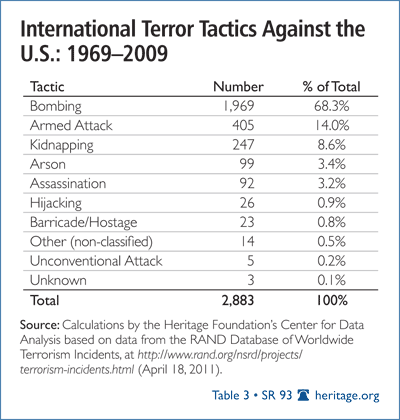
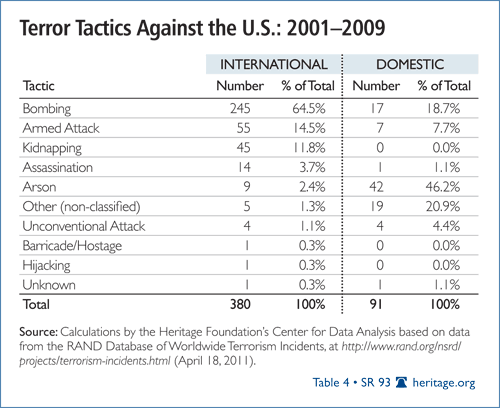
Table 4 presents the tactics used by international and domestic terrorists from 2001 to 2009. Of the 380 international terrorist attacks from 2001 to 2009, bombings accounted for 64.5 percent of all incidents. The second and third most prevalent tactics were armed attacks (14.5 percent) and kidnappings (11.8 percent). Of the 91 domestic terrorist incidents, arson accounted for 46.2 percent of incidents, while the second and third most prevalent tactics were “other” tactics (20.9 percent) and bombings (18.7 percent). The majority of domestic arson attacks were conducted by the left-wing Earth Liberation Front and Animal Liberation Front.
The Human Cost of Terror. From 1969 to 2009, 5,586 people lost their lives due to international terrorist attacks on U.S. interests. (See Chart 7.) (Of these deaths, 2,604 were not related to 9/11.) During this same time period, 16,334 people suffered injuries from terrorist attacks against the United States. (Of these, 13,997 were not related to 9/11).
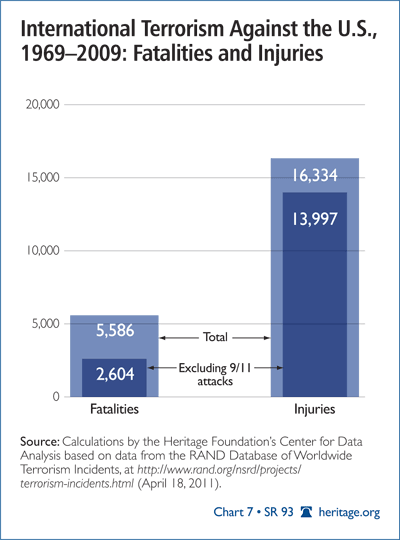
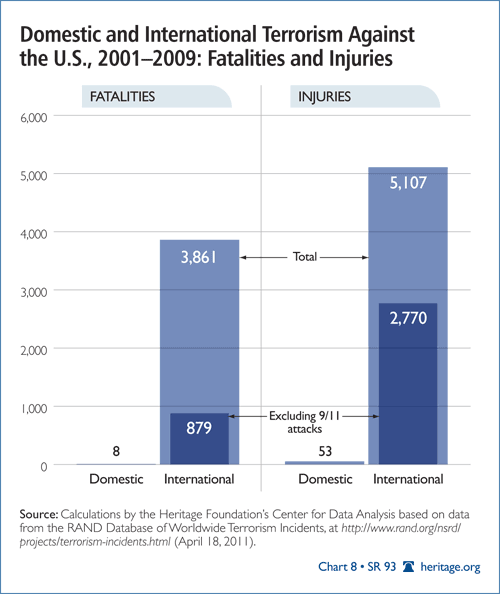
From 2001 to 2009, international terrorism caused far more fatalities and injuries among Americans than did domestic terrorism. (See Chart 8.) Domestic terrorist attacks killed eight people, while international terrorist attacks killed 3,861—more than 482 times the number of domestic terrorist fatalities. U.S. Army Major Nidal Malik Hasan murdered 13 people at Fort Hood in 2009, so the total number of domestic terrorism fatalities rises to 21. With this revised figure, the number of international terrorism fatalities is still nearly 184 times the number of domestic fatalities. More than 77 percent of the international terrorist fatalities are a result of 9/11.
During the same time, domestic terrorist attacks caused 53 injuries, while international terrorist attacks accounted for 5,107 injuries—more than 96 times the amount. Including the Fort Hood massacre adds 30 injuries, increasing the total number of domestic terrorism injuries to 83. With this revised figure, the number of international terrorism injuries is nearly 62 times the number of domestic injuries. 9/11 accounts for 2,337 injuries (45.8 percent) from international terrorism.
Table 5 presents the mean and median number of fatalities and injuries resulting from international terrorist attacks against the United States, listed by terror tactic, from 1969 to 2009. Due to 9/11, the most deadly international terror attacks employed unconventional tactics. Only five unconventional attacks, including the three incidents on 9/11 (the Pentagon, the World Trade Center, and the field in Pennsylvania), were carried out against the United States in 40 years.[14] These attacks averaged 596 fatalities per incident. However, calculations of any mean statistic are highly sensitive to extreme outliers, such as the 2,962 deaths on 9/11. The other two unconventional attacks—two Chilean seedless red grapes laced with cyanide were found in Philadelphia in 1989, and an envelope addressed to the U.S. embassy in Brussels containing the chemical warfare agent Adamsite was found in a postal sorting center in Belgium in 2003—did not result in any deaths. The second and third most deadly tactics were hijackings and bombings, averaging 7.0 and 1.0 fatalities, respectively.
For injuries resulting from international terrorist attacks against the United States from 1969 to 2009, unconventional tactics had the highest mean number of injuries per incident at 467. This statistic is due to 9/11, without which the number of injuries caused by unconventional tactics drops to zero. Bombings and hijackings averaged 7.0 and 6.2 injuries per incident, respectively.
Another important finding presented in Table 5 is that most international terrorist tactics used against the United States have been unsuccessful at causing fatalities and injuries. Only two international terror tactics have medians greater than zero: For assassinations, the median number of fatalities is 1.0, while the median for unconventional attacks is 44 fatalities. Excluding 9/11 attacks, the median for unconventional attacks is zero fatalities. For injuries, the median is zero for all tactics.
Tables 6 and 7 present the mean and median numbers of fatalities and injuries by international and domestic terrorist tactics used against the United States from 2001 to 2009. Overall, the tactics used in international terrorism generally produced higher average fatalities than the tactics used in domestic terrorism. (See Table 6.) The four international terrorist attacks using unconventional methods averaged 745.5 fatalities per incident. Once again this figure is driven mainly by 9/11. The remaining single unconventional attack, the Adamsite-laced envelope intended for the U.S. embassy in Brussels, yielded no fatalities, and 205 bombings averaged only 3.4 fatalities per incident. As demonstrated by the median number of fatalities, half of the tactics used in international terrorist attacks against the United States fail to result in a single fatality.
As for fatalities resulting from domestic terrorist attacks against the United States, the most deadly, on average, tactics that had more than one occurrence were armed attacks and other (non-classified) tactics, which each averaged 0.3 fatalities per incident. However, the mean for fatalities caused by domestic armed attacks does not include Fort Hood. While the most frequent domestic terrorism tactic is arson, with 40 incidents from 2001 to 2009, this method failed to produce a single fatality. As demonstrated by the median number of fatalities, most domestic terrorist attacks against the United States fail to result in a single death.
Table 7 presents the mean and median number of injuries by tactic used in international and domestic terrorist attacks against the United States from 2001 to 2009. The four unconventional incidents that were international in nature yielded an average of 584 injuries per incident. This figure, too, is mainly driven by 9/11. Excluding 9/11, the remaining single unconventional attack, the Adamsite envelope, yielded no injuries; 219 bombings averaged 11.9 injuries per incident, while 50 armed attacks averaged 2.3 injuries per incident. As demonstrated by the median number of injuries, most international terrorist attacks against the United States result in no more than one injury, and often none.
The most injurious domestic terrorist attacks were incidents that do not fall under a convenient category (labeled as “other”) and bombings. The 17 “other” tactics used by domestic terrorists averaged 2.7 injuries per incident, while the seven armed attacks averaged 0.9 injuries per incident. Once again, the mean for fatalities caused by domestic armed attacks does not include the Fort Hood shootings.
Conclusion
The past must not be discounted. Today, a decade after 9/11, examining terror trends of the past is vital to learning lessons and building better counterterrorism mechanisms. Combined with new intelligence, terrorism data from the past four decades can be an invaluable tool for reaching new insights, detecting previously unseen patterns, and sculpting and improving homeland security policy. It is up to the White House and Congress to ensure that the nation assesses all relevant information to address the threat of terrorism.
David B. Muhlhausen, Ph.D., is Research Fellow in Empirical Policy Analysis in the Center for Data Analysis at The Heritage Foundation. Jena Baker McNeill is Senior Policy Analyst for Homeland Security in the Douglas and Sarah Allison Center for Foreign Policy Studies, a division of the Kathryn and Shelby Cullom Davis Institute for International Studies, at The Heritage Foundation.
